“…a guy somewhere was sacrificing Black Lotuses to power out early War Mammoths, and wondered why in the heck Wizards felt the need to create a Restricted List. There will always be casualties in the crossfire, I suppose. I feel your pain.”
—Aaron Forsythe, “Latest Developments: Skullclamp, We Hardly Knew Ye.” June 4, 2004.
Jia Tolentino, one of the few “respectable” journalists to effectively chronicle our times, wrote beautifully about the aesthetics of “cursed” in The New Yorker this month; she traced the curse back to Grecian defixiones. These lead tablets were the size of a credit card (or a Magic card) and were buried in graves to “invoke . . . the ‘untimely’, who were buried there; these were persons who had died, whether through foul play or not, before what was thought to be their proper times and who were believed to have to wait in their graves—presumably with the opportunity to wander at night and to harm whomever the defixiones named-until their allotted years had passed and their souls could find rest.” [That’s the cited scholarship talking, not Jia.]
Excavations have found over a thousand of these original cursed icons. These defixiones mirror the “thanks I hate it”-inducing images we share with group texts, message boards, and group DMs, Ringu-style, to make certain that we don’t have to suffer alone. The internet has allowed us to share curses with the speed and potency of a disease, and has started serving us up these curses automatically. There are all kinds of defixiones buried in the algorithm, whether its memories of an ex that always seem to bubble up on TimeHop at the precise worst moment or the Facebook statuses of dead friends.
Because I always become an extremely sad sack of shit this time of year for Reasons, Spotify insists on reinforcing that. It prompts me every day in October, “hey, don’t you want to listen to Carrie and Lowell like you always do? Don’t you want to brood with some Zevon’s swan song or Leonard Cohen all the time?” It collects data based on my October-onset depression and seeds my playlists with sabotaging defixiones, no matter how many “I don’t like this artist” buttons I click on. That’s it’s own kind of curse.
Magic has defixiones, too—the cursed tablets whose legends define our culture. Umezawa’s Jitte, Hogaak, Arisen Necropolis, Field of the Dead, Time Vault—these are the Magic-specific myths we pass down to new micro-generations of players. Finding one of these in a collection or on the back page of a binder will fill you either with nostalgia, frustration, or epiphany, depending on when you got into the game. On the eve of a probable banning in Standard, I wanted to revisit some of these cursed cards and, true to the Halloween spirit, see whether we should still fear them.
Some quick notes: the Duelist Convocation International (DCI) was established extremely early in Magic’s history. The first banned list was in January of 1994, and was simply the ante cards plus Shahrazad. The Power Nine, plus an oddball list of cards, were restricted, some due to rules confusion or printer’s errors. The next year brought the establishment of Type 2, or Standard, and the first true ban of Type 2, which at the time was 4th Edition, Fallen Empires, Ice Age, Homelands, and Chronicles, was Banned List posterchild Channel. Next on the list was Mind Twist, as Dark Ritual fueling it on turn two or three, or double Ritual on turn one, was a terrible way to lose and almost as bad a way to win.
The most famous banned list reckoning came in early spring of 1999 with the release of Urza’s Legacy: a blisteringly fast Standard environment, supported by the artifact mana and infinite combos of Urza’s Saga, led to Dream Halls, Earthcraft, Fluctuator, Lotus Petal, Recurring Nightmare, Time Spiral, and Memory Jar being banned, with the Jar added in mid-March as an emergency, retroactive ban. It’s a shame—obviously, these cards are too powerful for Standard play, and were too effective for their costs; but they’re also incredibly fun to play with, as anyone who drafts the Legacy Cube can attest. These 1999 bans were the last Standard bans until my number five below:
No. 5—Skullclamp
Skullclamp is, like Smuggler’s Copter long after it, an issue of poor balance. The numbers are completely absurd—one to cast, one to equip, two cards drawn? Even without the +1/-1 effect, which allowed Clamp decks to translate Goblin tokens or outclassed Soldiers into “1: draw two cards,” Skullclamp would have been too powerful.
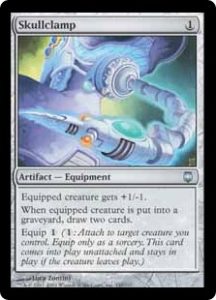
As printed—and Wizards has been up front about the poor organizational communication that led to the Clamp being printed—it was dominant in the most boring way. It ate a ban in June of 2004, after which Affinity continued to destroy the format, before receiving a massive ban in early 2005.
Fear Verdict: Scary in a folkloric way—a cozy kind of Sawney Beane serial killer tale you love to think about safely ensconced in your warm home.
No. 4—Recurring Nightmare
Riffing off of the overly-wordy but classic Animate Dead, Recurring Nightmare was meant to be a fun reanimation enchantment. But the then-recent game changing design—“enters play” creatures, like Nekrataal, Man-o’-War, and Uktabi Orangutan—meant something more abusive. You weren’t just getting a creature back, but effectively snagging a free spell in the bargain.
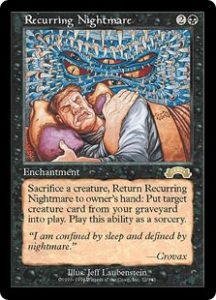
Combined with Survival of the Fittest, this allowed you to loop multiple creatures each turn while digging for exactly what you needed, which was usually a Spirit of the Night to close out games. Now, banned in Commander, it’s relegated to kitchen table Magic and every Cube ever.
Fear Verdict: Not scary, but kind of cheesy and joyfully janky—a well-made pulpy zombie movie, like Re-Animator or Return of the Living Dead.
No. 3—Aetherworks Marvel
A fun cheat card meant to tie the set’s mechanic into battlecruiser Magic, Aetherworks Marvel was designed to encapsulate the majesty and whimsy of Kaladesh while tempting kitchen-tablers across the world to build Energy decks. Instead, it spit out an Emrakul every time you spun the wheel. It got banned along with Emrakul because, even with her banned, there was always going to be a hyper-powerful runner-up.
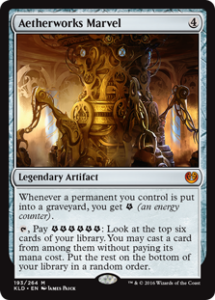
Cheating cards out once is fun—Goryo’s Vengeance, Through the Breach. Cheating cards out every turn is broken—Recurring Nightmare, Sneak Attack, or Vengeance/Breach spliced onto each other.
Fear Verdict: A Hitchcockian thriller or weird fiction cosmic horror where you don’t realize you’re in a trap until it’s closed around you.
No. 2—Jace, the Mind Sculptor
Oko, Thief of Crowns is a nuisance because he does everything well for three mana. Jace does everything superbly well for four. The first copy is backbreaking and demands immediate attention, during which your opponent is increasing their options, hamstringing your deck, and probably drawing another copy.
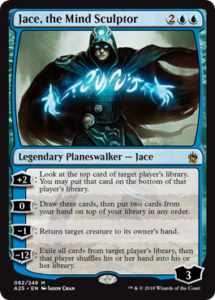
During his reign, he could be profitably attacked by Bloodbraid Elf or a Hawk with a Sword, but each attack that chipped away at Jace was another opportunity for your control opponent to get further ahead. Playing against Jace felt like you were playing Two-Headed Giant without a partner.
Fear Verdict: Unkillable franchise-figurehead like Pinhead, Jason, Freddy Krueger, etc.
No. 1—The Harrowing of Affinity
This, to me, is the worst-case scenario for a ban. Wizards bans cards when they’re too powerful or too format-warping, as Field of the Dead is right now. But the banning of Arcbound Ravager, Disciple of the Vault, and the six artifact lands was admission of failure on a massive scale.
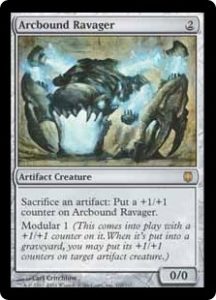
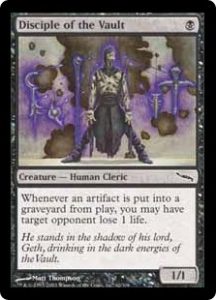
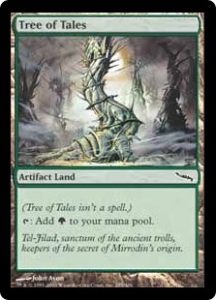
It wasn’t the banning of cards, but the banning of an archetype and a reckoning of design mistakes—an admission that Affinity was an inherently flawed mechanic, and one that a block was partially built around. Aaron Forsythe’s justification for the ban is a fascinating article because of what it admits without the veneer of corporate speak and forced positivity.
This was pre-stream, pre-boom Magic, when Magic Online was present but underpopulated; and so Wizards’ business model was built around getting people in physical stores to purchase physical cards. To do so, they had to kill an entire deck. Caw-Blade died, but U/W Control lived on. Rec-Sur was smothered, but G/B value engines still reigned. Urza Block brought mass bannings, but anyone who touched a Memory Jar or Tolarian Academy knew that was coming. Affinity was a statement of purpose, a full acceptance of Wizards as arbiter and executioner, right at the center of the supply chain.
Fear Verdict: The Exorcist—a sui generis horrorshow that brought new possibilities and traumas and a series of increasingly baroque sequels.
Afterwards
Talk to your Magic-playing friends about these cards and listen to their stories. Anyone who saw Combo Winter, Umezawa Standard, or Aetherworks Emrakul can tell you about the horrors they’ve faced. Those who weren’t around can imagine the power. That’s part of the glory of this game—even when it fails, there’s something undeniably attractive about its failures. Every “well, maybe this time they’ll unban Splinter Twin” post breathes new life into the legend.
Who can blame themiIn a Modern with Stoneforge Mystic back? Who can blame them, when Field of the Dead can go from a Limited/Constructed 0.0/1.5 to the potential chopping block? I expect we’ll see a shakeup by the time you read this; but for years to come, those minor defixiones, those cursed icons, will remain buried, waiting for some new player to uncover them, bring them to the kitchen table, and utterly destroy their friends. The spookiest, and most appealing, curse of all is the one that perpetuates itself, the kind that empowers and eradicates in equal measure.
A lifelong resident of the Carolinas and a graduate of the University of North Carolina, Rob has played Magic since he picked a Darkling Stalker up off the soccer field at summer camp. He works for nonprofits as an educational strategies developer and, in his off-hours, enjoys writing fiction, playing games, and exploring new beers.

